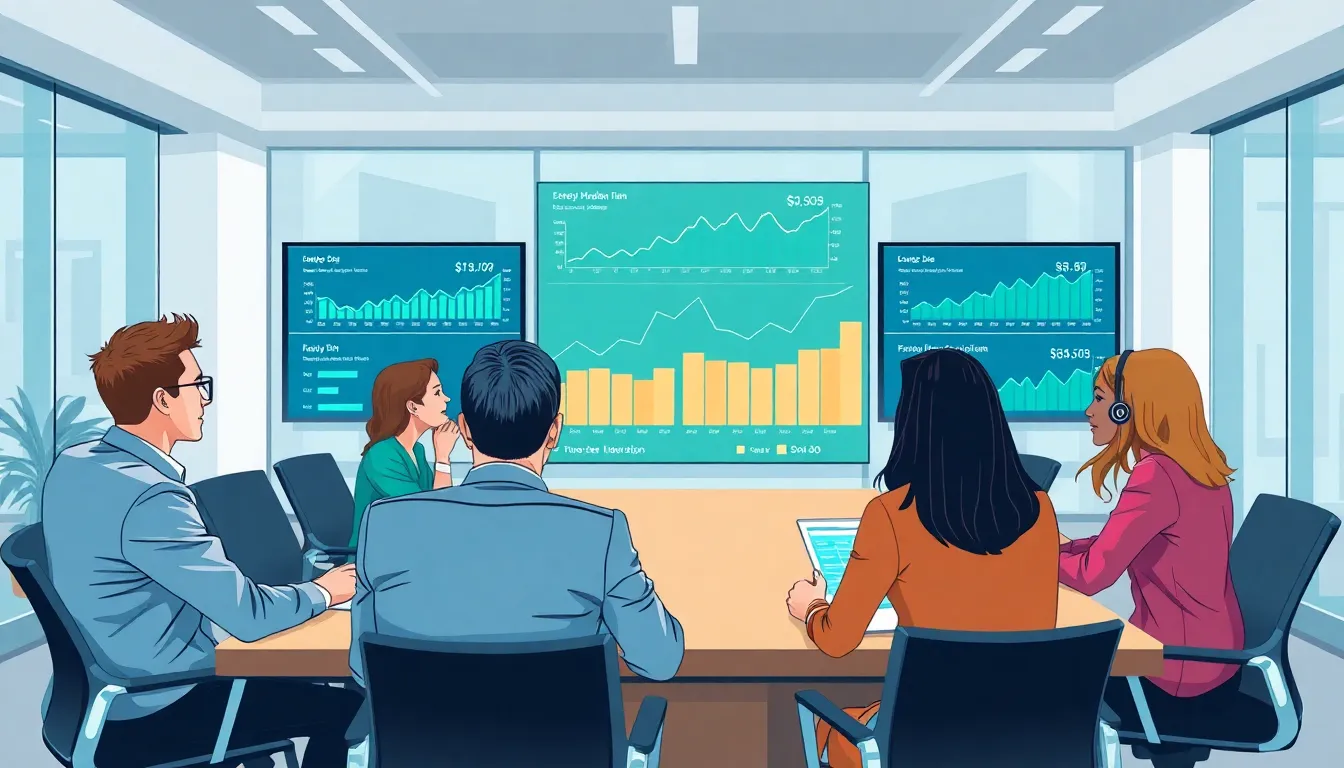Table of Contents
ToggleIn a world where the economy can feel as unpredictable as a cat on a hot tin roof, understanding the economic landscape is more crucial than ever. It’s not just about numbers and graphs; it’s about navigating the twists and turns that affect everyday life. Whether it’s inflation making your morning coffee more expensive or job markets shifting faster than a magician’s hat trick, staying informed keeps you one step ahead.
Overview of the Economic Landscape
The economic landscape reflects the interplay of various forces shaping financial environments. Understanding inflation trends plays a crucial role, as rising prices erode purchasing power. Job markets are evolving rapidly; sectors like technology and healthcare expand while traditional manufacturing experiences decline.
Countries face unique challenges; geopolitical tensions and trade policies impact global commerce. Consumer confidence directly influences spending, driving economic growth in many regions. Interest rates set by central banks serve as a tool for controlling inflation and stimulating investment.
Data indicates that small businesses contribute significantly to job creation, underscoring their importance in local economies. Economic indicators such as Gross Domestic Product (GDP) growth rates provide insight into overall health. Diversification among industries strengthens resilience against economic shocks, emphasizing the need for strategic planning.
Local factors often dictate success; regions rich in natural resources may see rapid growth while urban centers benefit from skilled labor pools. Adaptation to emerging technologies proves essential for businesses seeking long-term stability. Overall, the economic landscape remains dynamic, influencing decisions in both businesses and households.
Key Components of the Economic Landscape

Understanding the key components of the economic landscape reveals how interconnected various factors influence overall economic stability. Several critical elements shape this complex environment.
Economic Growth and Development
Economic growth reflects the increase in a country’s output of goods and services over time. It often indicates a nation’s overall health and competitiveness in the global market. Factors such as investments in infrastructure, technology, and education significantly contribute to development. Countries that prioritize innovation and skilled labor typically experience accelerated growth. As new industries emerge, traditional sectors may adapt or decline, showcasing the dynamic nature of economies. Investors often monitor GDP growth rates as they assess a country’s long-term viability.
Employment Trends
Employment trends illustrate shifts in job markets and workforce dynamics. The rise of technology and healthcare sectors highlights the evolving demand for skilled labor. Remote work and gig economies are reshaping employment formats, offering flexibility but also creating new challenges. Job opportunities in emerging fields contrast sharply with declining roles in manufacturing, leading to workforce displacement. Monitoring these trends helps businesses align their talent strategies and adapt to changing demands in various industries.
Inflation and Prices
Inflation directly impacts purchasing power and consumer behavior. Rising prices affect households and businesses alike, presenting challenges as costs increase. Central banks often intervene through interest rate adjustments to manage inflation and stabilize economic growth. Inflation rates influence consumer confidence, which in turn drives spending and investment. Businesses must adapt pricing strategies to maintain market competitiveness while addressing cost pressures. Understanding inflation trends enables stakeholders to make informed economic decisions.
Regional Economic Landscapes
Understanding regional economic landscapes provides insights into localized economic conditions and dynamics. These landscapes reflect diverse factors shaping both urban and rural areas.
Urban vs. Rural Dynamics
Urban areas experience rapid economic growth driven by services, technology, and innovation. Cities attract investments and talent, fostering startup ecosystems and vibrant job markets. Rural regions, conversely, often rely on agriculture and natural resources for economic stability. Employment opportunities in rural areas may be more limited, leading to population decline and dependency on urban economies. Adaptation plays an essential role in these dynamics, as rural communities work towards diversification to mitigate economic vulnerabilities. These differences highlight the unique challenges and opportunities faced within each landscape.
Global Economic Interdependence
Global connections significantly influence regional economic landscapes. Trade agreements and global supply chains shape the flow of goods and services, integrating local economies into the worldwide market. Economic policies and geopolitical events can impact export and import dynamics, affecting regional prosperity. Countries increasingly rely on each other for resources, technology, and expertise, creating a complex web of economic relationships. Understanding these interdependencies helps regions navigate global shifts, adapt to changes, and capitalize on new opportunities in the evolving economic environment.
Challenges in the Economic Landscape
Understanding the challenges in the economic landscape is crucial for navigating uncertainties. Several prominent issues affect countries and their populations.
Recession and Economic Downturns
Recessions disrupt economic stability by lowering consumer spending and investment. Various factors trigger these downturns, including rising unemployment rates and diminishing business output. In recent years, global events such as the COVID-19 pandemic exposed vulnerabilities in many economies. Countries faced drastic GDP contractions, with estimates indicating a decline of over 5% in some regions. Economic predictions often highlight the risk of prolonged downturns, making recovery efforts essential. Timely government interventions such as fiscal stimulus can mitigate some negative impacts, creating pathways for growth.
Inequality and Disparities
Inequality remains a pressing challenge in today’s economy. Wealth distribution disparities exacerbate social and economic tensions within communities. Data indicates that the top 10% of earners control nearly 70% of total wealth in many nations, intensifying calls for economic reforms. Educational access and job opportunities often vary significantly across different demographics, leading to persistent gaps. Understanding these disparities helps policymakers design effective measures to promote equity. Addressing gender and racial inequalities also plays a significant role in fostering inclusive economic progress. Initiatives to enhance skill development and increase minimum wages show promise in narrowing these divisions.
Future of the Economic Landscape
Anticipating the future of the economic landscape involves understanding emerging trends and challenges. Inflation is likely to remain a core concern, with continued rises in prices impacting consumers’ purchasing power. Job markets are expected to evolve further, focusing on sectors like technology, healthcare, and renewable energy. Traditional industries may face ongoing decline, necessitating workforce transitions.
Technological advancements will significantly shape economic growth, enhancing productivity across various sectors. These developments enable companies to leverage artificial intelligence, automation, and digital platforms, facilitating new business models. Observations show that remote work and gig economies continue to expand, providing flexibility while creating unique challenges for worker protections and benefits.
Geopolitical factors will maintain their influence on global commerce. Trade policies and international relations may create both opportunities for market expansion and risks of isolationism. Consumer confidence is pivotal, as it drives spending and investment decisions. Central banks may adjust interest rates to stabilize inflation and foster economic activity.
Investment in education, infrastructure, and clean technology will play a crucial role in future competitiveness. Countries prioritizing these areas can expect stronger economic resilience and adaptability. Small businesses will continue contributing significantly to job creation and innovation, proving essential for local economies.
Inequality remains a pressing issue that demands strategic reforms. Addressing wealth distribution disparities through equitable access to education and job opportunities can promote inclusive growth. Initiatives aimed at reducing gender and racial inequalities will enhance social stability and economic participation. Regions must collaborate to navigate changes in the global market effectively, ensuring sustained prosperity for all.
Understanding the economic landscape is vital for individuals and businesses alike. As inflation continues to impact purchasing power and job markets evolve, staying informed becomes essential. The interplay of technology, healthcare, and traditional industries shapes opportunities and challenges.
Regions must adapt to global economic shifts while addressing local disparities. Investment in education and infrastructure will be crucial for fostering long-term growth. By embracing change and focusing on inclusivity, communities can navigate the complexities of today’s economy and work toward a more equitable future.







